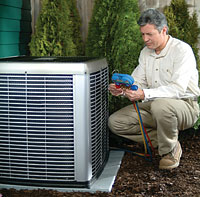
With R-22 scheduled to be banned for use in new equipment by 2010, manufacturers of air conditioning equipment stepped up the changeover of product lines to R-410A. There were questions about higher operating pressures and a learning curve with 410A, but training programs dealing with such matters were on the increase in 2004.
Production of R-22 for the aftermarket can continue until 2030, but supplies of the refrigerant will be gradually phased out.
During the past year, many in the industry predicted 2015 as a crunch year in which supplies of R-22 would fall short of need. While R-22 units can't be manufactured after 2010, equipment can be sold for as long as supplies last.

Venting Concerns
Glenn Hourahan, vice president of research and technology for the Air-Conditioning Contractors of America (ACCA), stated that many technicians are still blowing off refrigerant charges (primarily R-22) rather than recovering it.Warren Beeton, vice president of engineering at Copeland Corp., said atmospheric studies point to the same conclusion when he spoke at the Food Marketing Institute (FMI) Energy Conference in September.
ACCA called upon the Environmental Protection Agency (EPA) to better enforce its existing regulations against venting. However, the EPA admitted it doesn't have the manpower to monitor the situation closely, adding that the agency relies on whistle blowers within the industry to bring allegations to light.
Beeton's concern pointed to the fact that venting further depletes supplies of R-22, increasing concerns about future shortages.

Hanging On To HFCs
As an HCFC, R-22 has an ozone depletion potential (ODP). While HFCs do not have that problem, some concerns have been raised about their global warming potential (GWP). The industry stepped up its efforts during 2004 to ensure that HFCs have a long and viable future.Stateside, advocates argued that the global warming issue involves more than the choice of refrigerants. Global warming also results from burning of fossil fuels, which could increase with the use of less-efficient refrigerants, as well as from many other causes.
Beeton pointed out that R-410A is proving to be the refrigerant of choice for long-term air conditioning applications, primarily because it is efficient and cost effective. He joined with others in the industry to argue that a contained refrigerant is not an ozone-depleting refrigerant. Proper installation and service practices are a necessity.
In Europe, where use of R-22 in new equipment has been prohibited since 2000, industry officials were also working to preserve HFCs for the long term. At a major forum in Germany in October, efforts were made to get the European Union, which now numbers some 25 nations, to sign on in support of HFCs. The industry there committed to emphasizing proper installation, servicing, and technician training.
In Asia, R-22 remains more firmly entrenched, since it can be used in new equipment in that part of the world until 2030. But during the 2004 China Refrigeration Expo in Shanghai, a number of worldwide manufacturers stepped up awareness of HFCs, especially R-134a.
When HFCs were first developed, the industry determined that such refrigerants worked best with a synthetic oil like a POE, rather than the mineral oils used with CFCs and HCFCs. But 2004 also found several manufacturers introducing HFCs that they said could work with mineral oils.
CO2 And NH3
At the joint Compressor Engineering and Refrigeration conferences, held at Purdue University in Indiana in July, the use of CO2 as a refrigerant garnered increased attention. Four representatives of industry manufacturers and an end user from the U.S. Army talked about work they have been doing with CO2.During that October seminar in Germany, Hermann Renz of Bitzer cautioned that more research is needed to see if CO2 could be a viable refrigerant and at what cost.
In the ammonia refrigeration sector, researchers continued to explore ways to use that refrigerant in smaller systems.
At the International Institute of Ammonia Refrigeration (IIAR) conference, it was announced that a final draft had been completed on an Ammonia Refrigerant Management (ARM) program for plants with less than 10,000 pounds of refrigerant. ARM deals with various safety and regulatory issues and is considered an important component in encouraging use of ammonia in a wider range of facilities.
Publication date: 12/27/2004

Report Abusive Comment